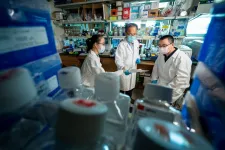(Press-News.org) LOWELL, Mass. - A UMass Lowell geologist is among the researchers who have discovered a new type of manmade quasicrystal created by the first test blast of an atomic bomb.
The formation holds promise as a new material that could one day help repair bone, insulate heat or convert heat to electricity, among other uses, according to UMass Lowell Prof. G. Nelson Eby, a member of the university's Environmental, Earth and Atmospheric Sciences Department.
Eby is a member of the research team that identified the quasicrystal substance inside samples of trinitite they examined that were collected from the debris of the first atomic bomb detonated by the U.S. Army on July 16, 1945 in the New Mexico desert. Also known as atomic rock, trinitite is a glassy material produced by the extreme heat and pressure unleashed by detonated atomic devices. The rock gets its name from the word "trinity," the U.S military's code term for the first nuclear test blast.
Naturally occurring quasicrystals have been found in meteorites and in structures impacted by meteorite strikes; researchers first discovered them in aluminum-manganese alloy in the early 1980s. While scientists have created quasicrystals in the laboratory since then, their discovery in trinitite represents the first known time the substance was artificially created, according to Eby, who lives in Burlington.
The quasicrystal the researchers discovered in the trinitite is shaped in an icosahedron, a solid, 3D structure with 20 faces. The material is composed of silicon, copper, calcium and iron that can be traced to source materials near the bomb site that were drawn into the enormous force of the explosion along with the desert sand.
"Quasicrystals are strange crystalline forms that do not follow the normal laws of crystal symmetry. The tremendous pressure and temperature generated by an atomic detonation can lead to new forms of quasicrystals, such as the one we identified that cannot be produced in a laboratory," Eby said.
The research team's findings were published last month in the academic journal Proceedings of the National Academy of Sciences. Along with Eby, scientists from the University of Florence in Florence, Italy; the California Institute of Technology; Los Alamos National Laboratory; Princeton University; and a researcher working independently contributed to the project.
Eby believes the growing understanding of the conditions under which various types of quasicrystals form can help scientists design them for specific purposes, such as heat insulation, converting heat into electricity, bone repair and use in prosthetics, he said.
An understanding of trinitite, which Eby and his students study in his UMass Lowell laboratory, is also vital, according to Eby.
"Because of concerns about the proliferation and possible use of atomic weapons by rogue nations and terrorist groups, over the past decade, forensic studies of radioactive elements contained in trinitite have been conducted by a number of academic and federal laboratories and institutions, including UMass Lowell," he said.
Such study is essential should scientists be called upon to assist in investigations of atomic activity, according to Eby.
"Materials recovered from a detonated atomic device would most likely contain remnants of the bomb, and knowing the relationship between glass chemistry and radioactive elements in the materials would be useful in characterizing the device and ultimately identifying the perpetrators," he said.
INFORMATION:
UMass Lowell is a national research university offering its more than 18,000 students bachelor's, master's and doctoral degrees in business, education, engineering, fine arts, health, humanities, sciences and social sciences. UMass Lowell delivers high-quality educational programs and personal attention from leading faculty and staff, all of which prepare graduates to be leaders in their communities and around the globe. http://www.uml.edu
New York, NY, June 3, 2021 -- A study of over 59,000 Icelandic adolescents by a team of Icelandic and North American behavioral and social scientists found that COVID-19 has had a significant, detrimental impact on adolescent mental health, especially in girls. The study is the first to investigate and document age- and gender-specific changes in adolescent mental health problems and substance use during the COVID-19 pandemic, while accounting for upward trends that were appearing before the pandemic. The findings are published in The Lancet Psychiatry.
The study found that negative mental health outcomes were disproportionately reported by girls and older adolescents (13-18-year-olds), compared to same-age peers prior to the pandemic. At the same ...
A first encounter with the dengue virus typically causes very mild symptoms; however, a subsequent infection is a different story. For a small proportion of people who are reinfected, the virus can cause severe symptomatic disease, which is often life-threatening.
"The main hypothesis for some time has been that antibodies generated the first time around, instead of providing protection against disease, can actually exacerbate it," says Stylianos Bournazos, research assistant professor at Rockefeller. "But even in secondary infection, we see a wide range of symptoms--so ...
As India continues to be ravaged by the pandemic, a Swansea University academic is investigating how green tea could give rise to a drug capable of tackling Covid-19.
Dr Suresh Mohankumar carried out the research with colleagues in India during his time at JSS College of Pharmacy, JSS Academy of Higher Education and Research in Ooty prior to taking up his current role at Swansea University Medical School.
He said: "Nature's oldest pharmacy has always been a treasure of potential novel drugs and we questioned if any of these compounds could assist us in battling the Covid-19 pandemic?
"We screened and sorted a library of natural compounds already know to be active against other coronaviruses using an artificial ...
Hospital price transparency is intended to help inform patients about the cost of services and procedures before they receive them. Since Jan. 1, 2021, hospitals in the U.S. have been required by The Centers for Medicare and Medicaid Services (CMS) to provide pricing information online about items and services. A team of researchers from Brigham and Women's Hospital and Massachusetts Eye and Ear leveraged the newly available data to analyze price transparency and price variation for the treatment of thyroid cancer. The team found that both transparency and price varied widely, with only half of the cancer centers studied reporting disclosure ...
EAST LANSING, Mich. - New research from MSU shows that an infant's gut microbiome could contain clues to help monitor and support healthy neurological development
Why do some babies react to perceived danger more than others? According to new research from Michigan State University and the University of North Carolina, Chapel Hill, part of the answer may be found in a surprising place: an infant's digestive system.
The human digestive system is home to a vast community of microorganisms known as the gut microbiome. The MSU-UNC research team discovered that the gut microbiome was different in infants with strong fear responses and infants with milder ...
EAST LANSING, Mich. - It can be easy to forget that the human skin is an organ. It's also the largest one and it's exposed, charged with keeping our inner biology safe from the perils of the outside world.
But Michigan State University's Sangbum Park is someone who never takes skin or its biological functions for granted. He's studying skin at the cellular level to better understand it and help us support it when it's fighting injury, infection or disease.
In the latest installment of that effort, Park, who works in IQ -- MSU's Institute for Quantitative Health Science & Engineering -- has helped reveal how the skin's immune ...
Toronto -- Math continues to be a powerful force against COVID-19.
Its latest contribution is a sophisticated algorithm, using municipal wastewater systems, for determining key locations in the detection and tracing of COVID-19 back to its human source, which may be a newly infected person or a hot spot of infected people. Timing is key, say the researchers who created the algorithm, especially when COVID-19 is getting better at transmitting itself, thanks to emerging variants.
"Being quick is what we want because in the meantime, a newly-infected person can infect others," said Oded Berman, a professor of operations management and statistics at the University of Toronto's Rotman School of Management.
This latest ...
ROCHESTER, Minn. -- A study by researchers at Mayo Clinic Cancer Center has found that cancer patients diagnosed with COVID-19 who received care at home via remote patient monitoring were significantly less likely to require hospitalization for their illness, compared to cancer patients with COVID-19 who did not participate in the program. Results of the study were presented Friday, June 4, at the American Society of Clinical Oncology Annual Meeting and published in the Journal of Clinical Oncology.
"For our study, we evaluated 224 Mayo Clinic patients with cancer who were found to have COVID-19 through standardized screening prior to receiving cancer treatment, or due to symptoms or close exposure," says Tufia Haddad, ...
While previous research early in the pandemic suggested that the vitamin D cuts the risk of contracting COVID-19, a new study from McGill University finds there is no genetic evidence that the vitamin works as a protective measure against the coronavirus.
"Vitamin D supplementation as a public health measure to improve outcomes is not supported by this study. Most importantly, our results suggest that investment in other therapeutic or preventative avenues should be prioritized for COVID-19 randomized clinical trials," say the authors.
To assess the relationship between vitamin D levels and COVID-19 ...
Effector and killer T cells are types of immune cells. Their job is to attack pathogens and cancers. These cells can also go after normal cells causing autoimmune diseases. But, if harnessed properly, they can destroy cancer cells that resist treatment.
Scientists at St. Jude wanted to understand how these T cells are controlled. They looked at enhancers, sequences of DNA that when bound to certain proteins determine how genes are turned on or off.
The scientists found that enhancers of a gene named Foxp3 work as a pair to keep effector and killer T cells in check. The enhancers working together is essential.
"These ...

